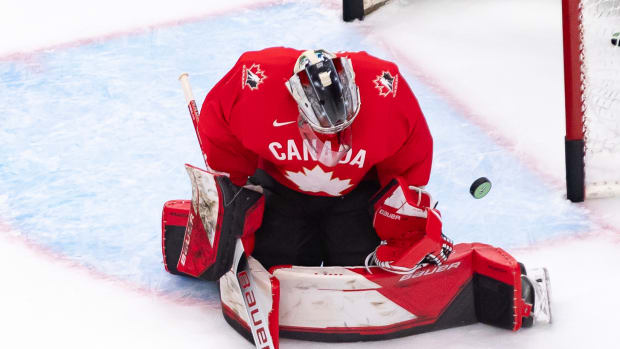The goaltending position is arguably the biggest impact spot on any hockey team’s roster. But as a terrific, recent piece in The Coast Halifax illustrated, netminding is becoming a lost art among Canadians, especially for those who have to invest their time, money and energy on a budget.
It’s difficult for young goalies to find ice time and appropriate instruction as they chase their competitive dreams, and even if they do thrive at elite levels, it’s a constant battle for them to feel satisfied and challenged as an athlete.
“It’s a business that’s at a crossroads in many ways,” said one former pro goalie, who spoke to THN.com on condition his name not be used. “Lots of kids love being the center of attention the way a goalie is the center of attention, but if they decide to commit to the position, all of a sudden there are these exorbitant costs they and their families face. It’s definitely not fair, but pretending they have the same types of opportunities as (non-goalies) is fooling yourself.”
As The Coast’s article made abundantly clear, it’s high time that the subject of goaltending, and all the issues that come with it – playing costs, equal tutelage, the ballooning prices of equipment and staying healthy at the professional level – are brought under a singular microscope.
Nearly 20 years ago, current Maple Leafs team president Brendan Shanahan led a committee to address and improve the overall NHL game. They called it ‘The Shanny Summit’ at the time.
Maybe it’s time for a ‘Shanny Summit’ for goalies.
Indeed, at a time when more NHL teams than ever are employing a balanced goalie tandem, wouldn’t an all-encompassing look at goaltending and getting ahead of the concerns and problems that affect netminders be a positive development?
Nobody is asking for the wheel to be invented, but before the sport brings in bigger changes – and we still think bigger nets would be a positive thing for the game – we should be exhausting all avenues and seeking out the wisdom gained by those who’ve played goal for a living to see if we can make some tweaks to the position.
“It’s not a bad idea, but you have to understand, there’s an entire industry that’s been built to keep things on the same course they’ve been on for decades,” the same former goalie said of a ‘Shanny Summit’ for netminders.
“People who’ve had skin in the game as far as the position goes won’t be gung-ho for change, but I think we should expect some pushback from them, and we can still do what we can to stay modern and help people who are asking for help to continue playing net.”
One of the longest-serving former NHL goalies, Kay Whitmore, remains with the league as one of its go-to minds on the position, but now that goalie icons Martin Brodeur and Roberto Luongo are retired, we could employ them to add new views to what they believe is best for goaltenders.
The alternative – allowing problems to metastasize, and more extreme changes to eventually come into effect – seems like a worse idea. It will take a leader willing to step up the way Shanahan did and admit that there are avenues for improvement, but goalies often are the ones with an independent streak and thus are willing to put their pride aside and allow change to take place. It just requires willpower and overall philosophical flexibility to get there.
One of the foundational changes to goaltending came with the advent of the “butterfly position”. A similar gestational view by goaltending gatekeepers should and would lead to better days for them.



